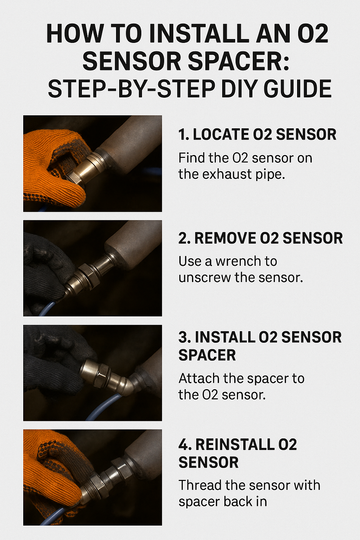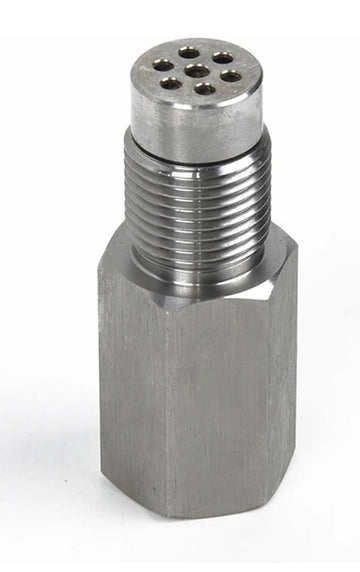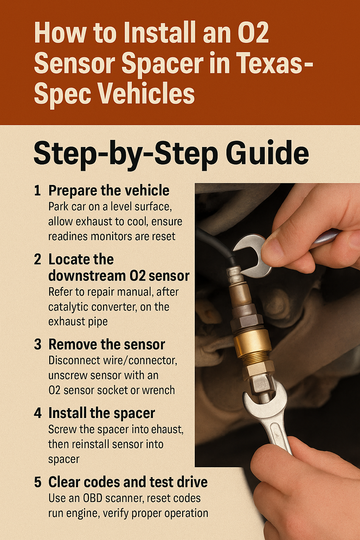Summary
Installing an O2 sensor spacer is one of the easiest and most effective DIY mods for addressing check engine lights caused by exhaust upgrades or high-flow catalytic converters. This guide walks you through everything you need to install an O2 sensor spacer correctly, safely, and legally.
Table of Contents
-
What Is an O2 Sensor Spacer?
-
When Should You Install One?
-
Tools and Materials Needed
-
Safety Precautions
-
Step-by-Step Installation Instructions
-
Post-Installation Checklist
-
Troubleshooting Tips
-
Spacer Options: Straight vs. Angled
-
Legal and Emissions Disclaimer
-
Frequently Asked Questions (FAQ)
1. What Is an O2 Sensor Spacer?
An O2 sensor spacer is a threaded adapter that positions the oxygen sensor slightly outside the main exhaust gas stream. It's commonly used to help reduce false catalytic converter efficiency codes (like P0420) without deleting the cat.
2. When Should You Install One?
-
After installing a high-flow catalytic converter
-
Following custom exhaust modifications
-
If you're receiving a P0420/P0430 code due to sensitive post-cat sensors
3. Tools and Materials Needed
-
Oxygen sensor spacer (straight or angled)
-
Oxygen sensor socket or 22mm wrench
-
Anti-seize compound
-
Jack and jack stands or car ramps
-
Protective gloves and safety glasses
-
OBD-II scanner (optional for clearing codes)
4. Safety Precautions
-
Ensure the vehicle is cool before working on the exhaust system
-
Use jack stands; never rely on a jack alone
-
Wear gloves and eye protection
-
Disconnect the battery if you’re working near electrical connections
5. Step-by-Step Installation Instructions
Step 1: Locate the Downstream O2 Sensor
Find the post-catalytic converter O2 sensor (Bank 1 Sensor 2 or Bank 2 Sensor 2).
Step 2: Disconnect the Sensor
Unplug the electrical connector and use the O2 sensor socket to remove the sensor from the exhaust pipe.
Step 3: Apply Anti-Seize
Apply anti-seize compound to the sensor threads (avoid the sensor tip).
Step 4: Install the Spacer
Thread the O2 sensor spacer into the bung where the sensor was removed. Hand-tighten, then snug with a wrench.
Step 5: Reinstall the Sensor
Thread the O2 sensor into the end of the spacer. Tighten securely.
Step 6: Reconnect the Plug
Plug the sensor back into the vehicle’s wiring harness.
Step 7: Clear Codes (Optional)
Use an OBD-II scanner to clear the check engine light, or drive the vehicle until the ECU resets.
6. Post-Installation Checklist
-
Ensure all connections are tight
-
Verify that the sensor cable isn’t stretched or touching hot components
-
Check for exhaust leaks
-
Drive for at least 50-100 miles to monitor code recurrence
7. Troubleshooting Tips
-
Still getting P0420? Try a spacer with a built-in mini catalytic converter
-
Clearance issues? Use an angled spacer
-
Sensor not threading easily? Inspect threads for damage and use anti-seize
8. Spacer Options: Straight vs. Angled
-
Straight Spacers: Easier to install in open spaces
-
Angled Spacers: Fit tighter or obstructed sensor locations
Some advanced spacers include mini cats for added effectiveness.
9. Legal and Emissions Disclaimer
O2 sensor spacers may not be legal for street use in all states or countries. They are intended for off-road or track use where allowed. Always check local emissions laws before installation.
10. Frequently Asked Questions (FAQ)
Q: Can I install a spacer without removing the exhaust?
A: Yes, most installations can be done from under the car without dropping the exhaust.
Q: Do I need to tune my ECU after installing a spacer?
A: No tuning is required in most cases, though results vary by vehicle.
Q: How long does it take to install?
A: Typically 15-30 minutes for most vehicles.
Q: Can a spacer damage my O2 sensor?
A: No, when installed properly with anti-seize, spacers do not harm sensors.
Need a quality spacer? Shop our O2 Sensor Spacer Collection for high-quality straight, angled, and mini-cat options for every application.


![ Fix P0420 Fast: Do O2 Sensor Spacers Really Work? [Legal Tips Inside]](http://ghalysmotorparts.com/cdn/shop/articles/ChatGPT_Image_Oct_10_2025_10_40_32_AM.png?v=1760118069&width=360)
![Do O2 Sensor Spacers Really Help Clear the P0420 Code? [Expert Guide]](http://ghalysmotorparts.com/cdn/shop/articles/ChatGPT_Image_Oct_9_2025_09_28_33_PM_654c1798-c0d4-428f-a5b6-f20b95661b54.png?v=1760129952&width=360)


